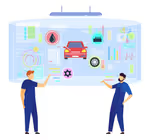
A Complete Guide to Hybrid & Alternative Vehicles Insights, Details, and Expert Knowledge
Hybrid and alternative vehicles refer to cars, buses, or other transport modes that use non-traditional propulsion systems typically combining an internal combustion engine with an electric motor or using alternative fuels such as hydrogen or bio-fuels. These technologies exist to reduce environmental impact, enhance fuel efficiency, and provide a bridge between traditional and electric mobility.
Hybrid vehicles help lower carbon emissions, improve energy security, and offer a smoother transition to sustainable transportation. They are designed to balance performance and environmental responsibility while maintaining the convenience of conventional fueling systems.

Importance
Hybrid and alternative vehicles are becoming increasingly relevant in the global automotive ecosystem.
Why it matters now
-
Environmental sustainability: They reduce greenhouse-gas emissions and support cleaner air in urban environments.
-
Energy efficiency: By combining electric power with fuel-based engines, hybrids optimize fuel usage and reduce overall consumption.
-
Economic impact: Hybrid technology helps nations reduce dependence on imported oil and manage fluctuating fuel demands.
-
Market growth: Consumer demand for energy-efficient and eco-friendly vehicles continues to increase across both developed and developing markets.
Who it affects
-
Consumers: Drivers gain access to vehicles that offer fuel savings and lower emissions.
-
Automakers: Manufacturers must innovate and comply with evolving emission regulations.
-
Governments: Policymakers focus on creating infrastructure and regulations to support sustainable mobility.
-
Environment and society: Reduced emissions contribute to cleaner cities and healthier communities.
What problems it solves
-
Reduces fossil fuel consumption and greenhouse-gas emissions.
-
Provides a practical alternative where electric charging infrastructure is still developing.
-
Helps automakers meet strict emission targets through technology diversification.
-
Supports a sustainable energy transition without fully abandoning existing fuel systems.
Recent Updates
The hybrid and alternative-vehicle market has seen major growth and transformation during 2024 and 2025.
-
Market expansion: The global hybrid-vehicle market is expected to rise sharply through 2035, supported by new technologies and broader adoption.
-
Consumer demand: Hybrids now account for a significant share of new vehicle registrations in several major economies, reflecting growing awareness of sustainability.
-
Automaker strategies: Leading global manufacturers are focusing on hybrid lineups to balance electric and fuel-powered vehicle portfolios.
-
Technological innovation: Strong hybrids now offer improved regenerative braking, better battery efficiency, and advanced energy-management systems.
-
Regional growth: Emerging economies such as India are experiencing rapid adoption of hybrid models, driven by rising fuel prices and interest in sustainable mobility.
This shift indicates that hybrids are evolving from transitional solutions to integral components of long-term automotive strategies.
Laws or Policies
Government policies play a vital role in shaping hybrid and alternative-vehicle adoption worldwide.
India
-
FAME-India Scheme: The Faster Adoption and Manufacturing of Hybrid and Electric Vehicles program encourages the production and use of energy-efficient mobility solutions.
-
Taxation: Hybrid vehicles currently face higher taxation rates compared with full electric vehicles, though state-level policies are under review to provide more balanced incentives.
-
Emission Standards: Type-approval norms under national automotive standards ensure hybrids meet strict emission and safety requirements.
-
Future focus: Central policies prioritize zero-emission mobility while still recognizing hybrids as essential in the transition phase toward electric vehicles.
Global Trends
-
Emission regulations: Many regions are implementing stricter fleet-average CO₂-emission limits, prompting automakers to integrate hybrid systems.
-
Incentive programs: Various countries offer rebates or reduced taxes for hybrid and plug-in hybrid models to accelerate adoption.
-
Infrastructure growth: Governments are investing in both charging and fuel-supply networks to support hybrid and alternative-fuel vehicles.
| Policy Area | Description | Key Impact |
|---|---|---|
| Incentives & Taxation | Incentives for hybrids and plug-in hybrids in select regions | Boosts consumer adoption |
| Emission Regulations | Stricter global CO₂ standards | Drives automaker innovation |
| Technology Approvals | Vehicle type-approval and testing standards | Ensures compliance and safety |
| National Energy Plans | Focus on reducing fossil fuel dependence | Promotes hybrid technology |
Tools and Resources
Professionals and consumers can use several tools and platforms to make informed decisions about hybrid and alternative vehicles.
-
Fuel Efficiency Calculators: Compare hybrid fuel economy with conventional vehicles to estimate savings and emissions reduction.
-
Emission & Energy Trackers: Tools to assess carbon footprints and analyze potential environmental benefits.
-
Government Portals: Platforms providing policy updates, vehicle certification data, and national mobility initiatives.
-
Market Research Reports: Industry insights into growth forecasts, consumer preferences, and new technology trends.
-
Charging Station Maps: Interactive apps to locate hybrid plug-in charging points and fuel stations.
-
Automotive Planning Tools: Software that assists fleet managers in evaluating energy costs and long-term sustainability impacts.
These resources help individuals, businesses, and policymakers plan and monitor hybrid-vehicle adoption effectively.
FAQs
What’s the difference between hybrid, plug-in hybrid, and electric vehicles?
-
Hybrid vehicles (HEVs): Combine an engine with an electric motor; the battery recharges automatically while driving.
-
Plug-in hybrids (PHEVs): Offer both plug-in charging and fuel-engine operation for longer range.
-
Electric vehicles (EVs): Fully powered by batteries with zero tailpipe emissions.
Are hybrids suitable for everyday use?
Yes. Hybrids perform efficiently in both city and highway driving, offering a balance between performance and sustainability. They are ideal for drivers seeking better fuel economy without depending on charging networks.
Will hybrids remain relevant as full EVs grow?
Yes, for the foreseeable future. While EVs represent the long-term goal, hybrids serve as a crucial bridge, especially in areas where charging infrastructure is limited.
What are the benefits of owning a hybrid vehicle?
-
Improved fuel efficiency
-
Lower emissions
-
Reduced noise pollution
-
Smooth driving experience
-
Longer engine life due to optimized energy management
What are the limitations of hybrid vehicles?
-
Higher upfront price than conventional vehicles
-
Dependence on fossil fuels
-
Complex systems that may require specialized maintenance
-
Fewer incentives compared with fully electric models
Conclusion
Hybrid and alternative vehicles represent one of the most significant advancements in modern transportation. By combining energy efficiency, cleaner technologies, and flexible design, they serve as a critical bridge between conventional and electric mobility.
Their increasing popularity highlights a growing commitment to environmental responsibility, energy security, and innovation. While policy frameworks and tax structures vary globally, the long-term trajectory shows hybrids becoming an integral part of sustainable mobility ecosystems.
In the coming decade, as electric infrastructure matures and hybrid technology continues to advance, these vehicles will remain essential to the global shift toward cleaner, smarter, and more efficient transportation solutions.




